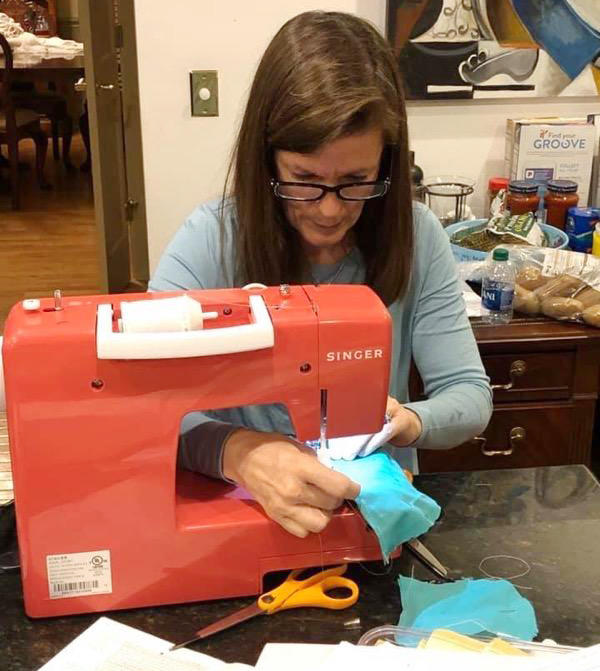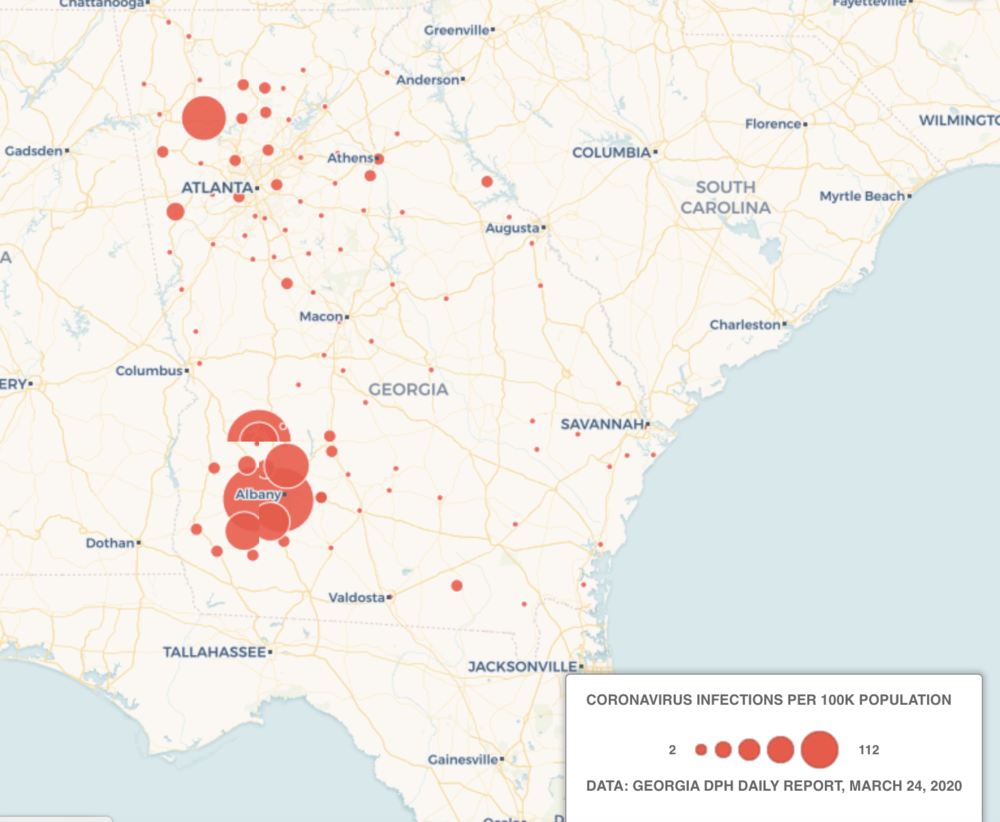Section Branding
Header Content
In COVID-19 Hotspot, Handmade Masks Help Stretch Medical Supplies
Primary Content
Leslie Owens will tell you: sewing is not really her thing.
“Full disclosure, I really haven't touched a sewing machine since Home EC in seventh grade,” Owens said. “That was a long time ago.”
But Owens’ home is in Albany, the same city that’s the heart of a southwest Georgia coronavirus outbreak where the per capita infection rate is the highest in Georgia. At the region’s largest hospital, Phoebe Putney Memorial, the COVID-19 deaths account for about a third of the deaths across the entire state. Medical supplies to keep health care workers safe are running short.
So, lately, Leslie Owens has been brushing up on her middle school sewing skills.
In COVID-19 Hotspot, Handmade Masks Help Stretch Medical Supplies
Several times a day she fires up the sewing machine in her Albany home, stitches together four pieces of surgical linen pre-cut into half-moon shapes and adds a couple of elastic straps. After a few stitches and a few snips of the scissors, she has a protective mask covering that will go back to the hospital.
Meanwhile, Owens is sheltering in place with her four kids. Plus she has elderly relatives to check in on, remotely. Her husband is a doctor in the local neonatal intensive care. She feels compelled to pitch in.
“The thought came to mind that, you know, back in World War II, when Rosie the Riveter went into the factory, she didn't have any prior experience,” Owens said. “But it didn't stop her from trying.”
Over the last weekend, Owens and her family put together 40 masks covers.
MAP: Georgia Coronavirus Infection Rates Per 100k People
Wendy Light said that takes the total number of volunteer-made mask covers to around 400. In her day job Light helps manage a staffing company for temporary workers. So, organizing these volunteers isn’t a big leap.
mso-bidi-font-family:"PT Mono"">“I definitely can't sew. So this is how I can help,” Light said with a laugh.
Light said she has about 31 locals at work making the protective covers. Some are quilters or people with sewing-related businesses. Light talks to the volunteers constantly, but in the interest of social distancing she hasn’t met any of them in person, not even to get them their raw materials.
mso-bidi-font-family:"PT Mono"">“What we're doing is we've got bags, and we'll put the masks that need to be sewn in bags out on our back steps,” Light said. “And people will come pick them up and then drop off completed ones.”
mso-bidi-font-family:"PT Mono"">It’s a little cloak-and-dagger, but it’s meant to let materials change hands without endangering people.
mso-bidi-font-family:"PT Mono"">“So we're trying to do our best to keep people safe,” Light said.
color:#666666">Light said word of the work, and people’s willingness to take it up, is still spreading.
color:#666666">“For every one person that contacts me, on average, I'm getting two or three referrals from them,” Light said. “You know, ‘Hey, this person wants to help, too.’”
The handmade mask covers end up at Phoebe Putney Memorial Hospital where Dr. James Black is the head of Emergency Medicine.
Black said once you add volunteer totals to what hospital employees have made in house, he has over a thousand of the handmade protective masks. He said the covers are being used to extend the life of the super valuable n95 respirator masks you may have heard of. Those are in short supply everywhere. Typically, they are used without any covers at all.
mso-bidi-font-family:"PT Mono"">“
mso-bidi-font-family:"PT Mono"">If you use the mask in that fashion, it becomes a single use mask,” Black said.
Last week the hospital ripped through five normal months of supplies like the N95s in about six days. So they began using disposable surgical masks as N95 covers to extend the respirator masks’ lives. Black said that worked, until the surgical masks became rare, too.
mso-bidi-font-family:"PT Mono"">“
mso-bidi-font-family:"PT Mono"">So the CDC came out with guidance that you were allowed to fabricate your own mask coverings,” Black said.
The covers aren’t being used alone, but the plans include instructions for special treatments that allow the N95 covers to be laundered and used again and again. Black said that extends the life of the N95s.
mso-bidi-font-family:"PT Mono"">“It allows you to use them over multiple rooms, and extends your supply several fold,” Black said.
mso-bidi-font-family:"PT Mono"">As a result the hospital has not run out of the precious respirator masks, thanks in part to volunteers.
mso-bidi-font-family:"PT Mono"">“They bridged the gap and they haven't let us down,” Black said. “And it's been great.”
mso-bidi-font-family:"PT Mono"">That’s why Leslie Owens and others are still at their sewing machines, even if Owens said her work might not be much to look at.
mso-bidi-font-family:"PT Mono"">“It may not be the prettiest mask in the world,” she said.
mso-bidi-font-family:"PT Mono"">But until factories make more N95 masks, the handmade covers will still have a job to do.



